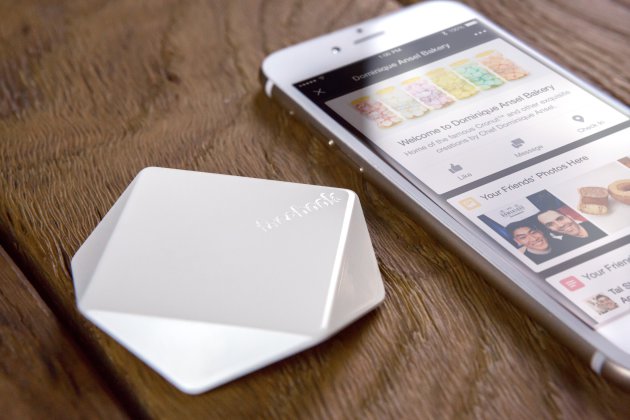
Facebook yesterday updated its Place Tips feature and is passing out free beacons to SMBs. There are many implications that have already been unpacked across the blogosphere. But one under-recognized angle is how this fills a longstanding gap in offline attribution: identity.
As quick background for those unfamiliar, Place Tips launched in January as an extension to the Nearby Friends feature. Comments, pictures and other chatter happening in and around business locations are shared with Facebook friends who subsequently visit or pass those places.
In order to pinpoint those users, Facebook knows that beacons have the most accurate low-range signal, especially indoors. This is where the free beacons come in. So it’s a sort of Trojan Horse into SMB relationships, using free beacons and the promise of proximity marketing.
That’s interesting on its own, giving Facebook a leg up in getting the attention — and the dollars — of SMBs. This is an increasingly crowded and competitive area where Facebook is pulling ahead due to its reported Pages numbers, and BIA/Kelsey SMB survey data.
A New Way
But there’s more to it, related to the elusive art of offline ad attribution. As explored in our attribution white paper, there are several methodologies to link online ad exposures with offline conversions, many of which extrapolate based on sample groups.
For example, ad exposed-control groups are matched to regional sales lifts. Other methods probabilistically link ad exposures to payment data. And then there’s the early but promising area of mobile payments to connect the dots in the path to purchase.
Facebook has now unveiled another way: authenticating store visits via social identity. Because its app is so prevalent — often running in the background in iOS and Android — it can be that missing link between online/mobile ad engagement and store visits.
Put another way, Facebook users’ identities are present when they’re signed in and engaging with content and ads. They are also present and unobscured when those same users are signed in and bouncing around the offline world, including store visits.
There are lots of ways this can play out including Facebook’s own mobile ad efficacy. It also ties in with its Facebook Audience Network (FAN) to power and get a rev share for app partners. Offline tracking joins that targeting data in potentially powerful ways.
Connect the Dots
The challenge will be getting SMBs to adopt, and getting users to turn on location sharing in the Facebook app. Facebook has the firepower to incentivize both. For SMBs, that happens through bankrolling lots of shiny new beacons. The question is if they’ll bite.
For users, the incentive is giving them reasons to share location. For example the Facebook app currently requires location sharing to see friends’ location activity. If it can incentivize this sharing en masse, it will unlock an entirely new area for mobile advertising.
Facebook knows that the majority of its ad revenue is mobile; and the majority of mobile-influenced commerce is offline. It’s not the first to realize this. But it could be the first with a massive graph of signed-in users to directly connect the digital and physical worlds.
______
Related: Verve Mobile today acquired Beacon technology provider Fosbury, to create a more direct link between ad exposures and in-store visits. This follows past moves by Verve to close the attribution loop at the physical store level.
This Post Has 3 Comments
Leave a Reply
You must be logged in to post a comment.

A great solution for offline ad attribution for retailers. Huge upgrade from impressions/clicks.
Unfortunately arrivals at store and basket-level transactions are the brand manufacturer’s equivalent of clicks (or perhaps secondary actions). Brands need to know if the shopper came in with the intention to buy (or look) at their specific advertised product/SKU, did they pick-up their specific advertised product/SKU, and did they buy their specific advertised product/SKU. Using store-specific sku-specific data, brand manufacturers can look at the sales lift they are getting on their digital advertising (typically 5-20%) and the ROI (which varies greatly by brand and product category).
Great point Jeremy. FB is really only covering a store visit and not a transaction. The latter would paint a more complete picture of ROI and attribution. Facebook’s moves in payments via Messenger (currently more of a p2p play) could be one way they get closer to the full closed loop.
Jeremy. we have been successful in demonstrating offline attribution in the automotive space. looking to expand to additional consumer segments. chat more?